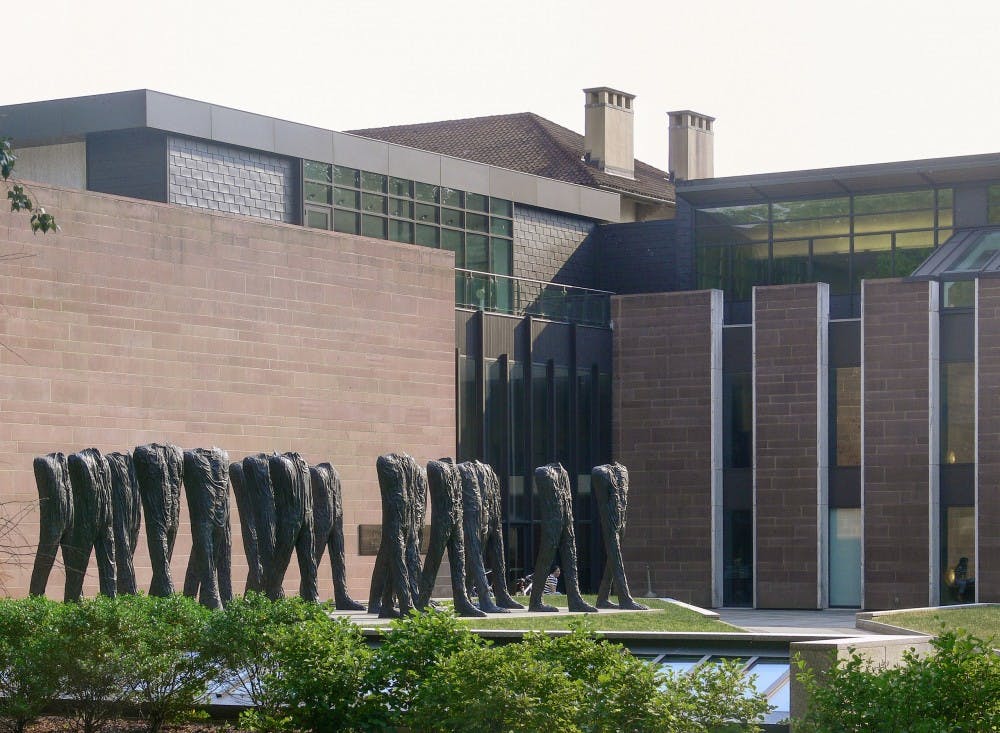Perusing the galleries of an art museum, we often view artworks as portals into history. Less often do we contemplate the history of the physical piece in front of us. What we see is often enhanced by the quiet yet immensely difficult work of art conservators. On May 2, Princeton University Art Museum’s conservator, Bart J.C. Devolder, delivered this year’s Friends Annual Mary Pitcairn Keating Lecture: “A New Day for Art Conservation at the Art Museum.” During his talk, Devolder outlined the past, present, and future of conservation at the museum, shedding light on his own role in this trajectory.
Devolder has always been drawn to art, especially paintings. As a child, Devolder dreamed of being a painter, but his parents disapproved. Yet he does not identify as a “frustrated painter.” He realized early on that the path wasn’t for him when someone asked if he “[woke] up in the middle of the night with the urge to paint,” and the answer was no. Devolder ended up earning an M.A. in painting conservation from the Royal Academy of Fine Arts in Antwerp, Belgium, in 2002. Before arriving at Princeton in July 2018, he worked for expansive federal institutes, such as the National Gallery of Art in Washington, D.C., as well as smaller university museums.
He prefers the latter, saying, “It is great I have so many opportunities to interact directly with the students.” Perhaps Devolder’s greatest claim to fame is his leadership role in the restoration of the Ghent Altarpiece Restoration Project. In his introduction at Thursday’s lecture, Museum Director James Steward likened the importance of this project to the restoration of the Sistine Chapel ceiling. Now Steward anticipates a “new period of vitality under Bart’s leadership” at Princeton’s art museum.
Devolder sees art through a scientific lens. He is fascinated by materials, such as pigments, and enjoys researching and creating them. The smallest details, like how differently shaped brushes affect the application of paint, capture his interest. But while objectivity and scientific analysis are important elements of his job, there is an art to it as well. There is no easy formula for any given restoration. One of his first projects at Princeton was an icon of Saint Nicholas from the late 18th to early 19th century, whose paint bubbled up as the wood panel shrank. There were only two options: place the panel in a humid space to expand it, risking damage to the painting’s silver, or push the paint back down in hopes that the panel still had room to accommodate it. He chose the latter and successfully restored the piece.
Conservators face the challenge of not only determining how to restore a painting but also whether to restore it at all. If a piece is extremely deteriorated, a conservator risks what is known as “hyper restoration,” which can verge on forgery. Each conservator may have their own style and techniques, but they must be wary of going too far in asserting themselves on the canvas.
As technology continuously develops, conservators are able to view art in ways never possible before. Using tools like UV lights, they can X-ray artwork to see the different layers of paint and determine what is part of the original work and what was added later. For instance, several of Manet’s paintings were completed or modified after his death. His painting ca. 1877–79, “Young Woman in a Round Hat,” currently hangs in our museum’s galleries. Devolder discovered that certain spots on the painting were filled in or painted over after Manet’s death. Devolder made the choice not to remove the added paint. As a conservator, he thus has a direct impact on the images that greets us as we wander through our museum’s exhibits.
Yet Devolder recognizes that one conservator’s choice should never have a permanent impact on an artist’s work. Everything he does can be reversed at a later date. In this way, an artist’s original work, insofar as it has survived, can always be recovered. Restoration is a delicate process: there is freedom of choice, but a conservator must determine the limits of this freedom. They must adapt to constantly shifting technologies and decide how this technology will impact their work. Devolder illuminated how conservation sits at the intersection of art and science.
Devolder hopes to see his work intersecting with departments all across campus, and he is excited to see how conservation can modernize and expand at Princeton. He acknowledges that only nine percent of Princeton’s collection are paintings, his specialty. Princeton needs to hire more conservators for objects, prints, drawings, and photography. Devolder envisions conservators of different specialties learning from each other and collaborating on certain projects.
The new art museum is breaking ground at the end of 2020, and its construction means more than just bigger and better exhibition space. It will likely feature a larger conservation lab, making Devolder’s goals for “A New Day for Art Conservation at the Art Museum” possible.









